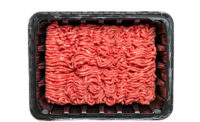
|
Q: What primary area of use (i.e. frozen, what species, what type/style of product, etc.) does form/fill/seal technology fit best into in the protein-processing industry?
The more precise question may be, “What primary form/fill/seal package is best for protein overall?” The answer is thermo-form. It’s more versatile using the same equipment system because you can produce small format and larger format packages by just changing dies.
Q: Describe some of the challenges processors must be aware of when adopting form/fill/seal technology into their processes.
Seal contamination, because processors are forming and loading the package themselves. Loading — meaning bringing product to the equipment — may lend itself to more manual loading because there isn’t the variety of loader options to choose from as there is with bags. Equipment options — there are many options to choose from: thermo-form, flow-wrap, vertical, horizontal, gas-flush, vacuum. Also retail or foodservice package, printed package or no print, and registered print or random print [pose challenges].
Q: What about on the materials side? Are there considerations processors must make in regard to the actual packaging materials when it comes to form/fill/seal technology?
The short answer is, yes. Cost of materials is a primary concern. Does the processor have multiple supplier options? Does the material comply with the requirements of the application, i.e. cook-in? Is barrier required, gas-flush, vacuum, shrink, abuse resistance? If the package requires two webs then they must be compatible. If the package is printed then that will affect the material selection because it will need to be less stretchable for registered print. In today’s environment package sustainability and recyclability are considerations.
Q: Are the challenges mentioned above easy to solve? Either way, what types of technological advancements are needed to bring solutions into the industry?
There’s not much left to do that can significantly drive down packaging costs. The shift is toward more sustainable packaging, but without raising costs, [as well as] any packaging options that can help promote improved food safety and improved shelf-life for products.
Q: How significant has been the effect of exact-weight/net-weight products on the form/fill/seal arena?
Form/fill/seal gives more packaging options to take advantage of exact-weight products.
Q: Do you believe this technology has room to grow in the protein-processing industry, or has the industry tapped the full potential of the process to this point?
There is incredible growth left, but most likely at the expense of bags. Form/fill/seal gives greater packaging options and reduces overall packaging costs because there are more suppliers to choose from and more equipment systems options.







